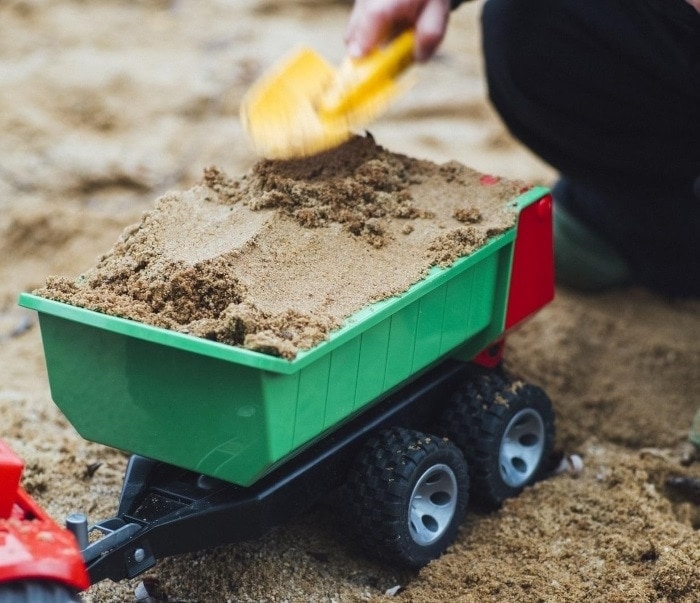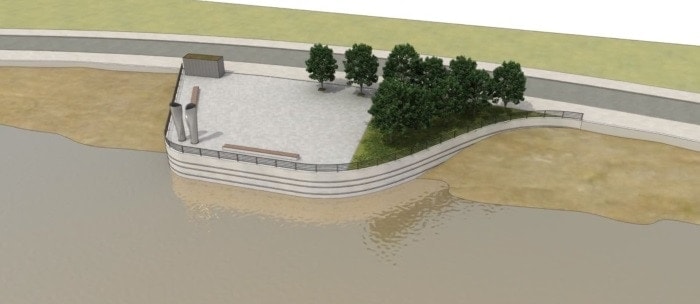
When you dig a tunnel, what happens to all the "earth" that is unearthed?
28 of January of 2019
A tunnel is a conceptually simple concept: a hole in the ground, generally horizontal or with a light slope. Highway tunnels that go through mountains, underground metro lines, or urban sewer pipes are types of tunnels that are everywhere.
Mathematically, a tunnel is a “subtractive operation” that extracts soil or rock from the ground. This way, the space that previously occupied that piece of land makes up part of a hole through which water, people, materials, etc. pass. But, when a tunnel is dug, what happens to all the extracted material?
When a tunnel is dug, a lot of material is turned up
If you have ever spent the summer at the beach and dug a small trench, you quickly realized that, with each shovelful, you have to move the wet sand a little farther away. At the start, it piles up near the whole, but the mountain soon reaches significant dimensions. Let’s do some simple math: how much sand, clay, or rock has to be moved for a tunnel that my car can fit through?
To simplify our calculations, let’s suppose that the tunnels are perfectly circular and that their diameter is 5 meters. A real tunnel will depend on the number of lanes and the regulations of each country, of course. Do you remember the formula for the volume of a cylinder that you saw in school? V=π·r2·l, where r is the radius and l is the length.
A tunnel with a 2.5-meter radius (it is a very small tunnel) and a length of 100 meters (again, small) gives us a volume of 1,963 cubic meters of material. To give us an idea of whether that is a lot or a little, let’s think about the fact that a cement truck has the capacity for 6 to 9 m3, and that a garbage truck has around 7 to 20 m3.

Source: Unsplash | Author: Markus Spiske
A dumper, a vehicle specialized for carrying dense materials like rock or soil, usually has at most 10 m3. Since rock weighs a lot (and therefore takes up less space), let’s use it as an example. To make a small tunnel with only one lane over a very short distance, we need around 200 trips to take the materials extracted to somewhere else. Imagine a large construction project.
Recycling construction materials
With this very basic, small-scale calculation in mind, let’s take a stroll through London and some of the projects that Ferrovial is working on, such as the Tideway project to expand the network of the sewage system, or the expansion of the Elizabeth line. In the first case, let’s think about a hole 32 meters in diameter and 53 meters tall that is needed for lowering tunneling machines.
Again, applying the above formula, we get a volume of 42,625 cubic meters. Even if this was all compact rock at 2,000 kg/m3 (it was not – there was a lot of sand, clay, or mud), we are talking about more than 85 million kilograms just for the auxiliary hole, without taking into account the construction of the tunnel itself. What can we do with all this material?
One of the most frequent uses for the leftovers of an excavation is recycling the materials. Oftentimes, the materials left over from opening a tunnel are sold on the materials market to companies that are looking for certain construction elements. For example, sand for building photovoltaic cells or gravel for city parks.
Occasionally, recycling is done in situ, like when extracted materials are used to fashion other necessities. The typical example is concrete. In a construction project where tens of metric tons of sand and gravel are extracted, it is fitting that some of the material returns in the form of concrete. Shipping sand and gravel off from the construction site just to bring more in does not make any sense, in addition to not being very sustainable.
Remains from a mountain tunnel to level the access road
A real, very common case – especially high in the mountains, in isolated areas, and on secondary roads with very little maintenance – is using some of the excavated rock to improve the access road to the tunnel. Topographers use dense materials to widen the roadway.

Source: Unsplash | Author: Wenni Zhou
Taking the above image as an example, how can we widen the roadway? One possibility often used on hills with low slopes is excavating on the level the same width of the hill, but when we have slopes such as those shown in the photograph, this does not work in safety’s favor. We need to widen the outer side of the slope, adding material until reaching the level of the road.
Occasionally, to add a certain amount of width to the roadway, a gentle slope that takes up much more vertical distance is needed to get to the bottom. Something similar occurs with the profile of dams, which slopes against the load and makes use of compacted earth to secure the slope.
As can be observed in the profile of a dam, this produces an enormous need for materials. Using materials from the excavation itself is a way of reducing the environmental impact of the expansion. If both construction projects are done simultaneously or back-to-back, we will have interesting synergy.
The fixed cofferdams of the Thames will use local materials
In another article, we have mentioned how the Thames cofferdams are built for the Tideway project. These auxiliary structures will be permanent, and they will use a large quantity of local materials. In the image below, we can see an example of them. Though it is irregular, we can simplify the figure to a rectangle of approximately 70 meters by 35 meters.
That gives us an area of 2,450 m2 and a volume of 24,500 m3 of materials for a cofferdam elevated at about 10 meters above the Thames. In some areas of the river, the walls will be elevated even higher. But regardless of how we make the calculations, it is easy to see that this type of construction work requires additional material.

Source: Tideway
Additionally, when the time comes to compact the land in the area to augment the building’s future safety, we have to keep in mind the way that it slopes down and the need for adding more layers of earth.
These two examples are not the only possibilities. Some years ago, the Albertia Tunnel (Guipúzcoa), built by Ferrovial Agroman, reused 700,000 m3 of materials that came from the excavation in order to prevent the environmental impact of the construction work itself, in addition to conserving local species when it came to covering the space used.





There are no comments yet